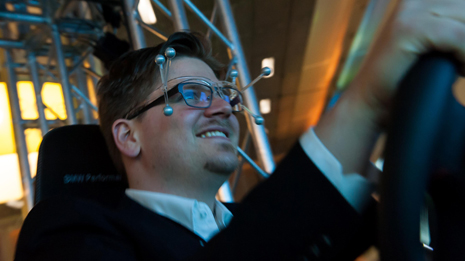
September 2013 saw the release of RTT DeltaGen 12, the latest version of the flagship software from RTT, the leading provider of professional high-end 3D visualisation in realtime.
We caught up with Benjamin Becker, product manager at RTT, to discuss the implication of DeltaGen 12 for the design and development process.
DeltaGen is used heavily in the automotive sector. How well does it extend into other sectors e.g. product design, aerospace etc.?
Indeed, automotive is our home base – but you will be astonished to see how many websites feature automatically rendered product images – from footwear to apparel, from aerospace to transportation. This trend is visible not only in marketing, but already much earlier in the product cycle, starting with design and development. The choice of colour and trim variants, for example, is an integral part of almost any design process in most industries. If you look at transportation and aerospace, you are looking at stringent ergonomics reviews. In the lifestyle sector – fashion, footwear, apparel, etc. – the deepening product customisation is changing the design landscape. We are looking in all of these directions.
Explain the workflow from CAD to DeltaGen. What formats are supported?
The basis for all working steps is the 3D reference model based on CAD data, which is created in the product development process. This data is usually provided in different formats depending on which programs the PLM participants are working with. DeltaGen is able to handle formats from all current 3D software or CAD systems, amongst others CATIA, NX, ProE, Maya and open standards such as STEP and JT.
In order to have an efficient workflow, it is mandatory to prepare and clean-up the data in such a way that all the rich information on materials are easily accessible and available, e.g. material assignment tables and material variants can be attached to the 3D reference model to instantly provide highly realistic visualisation results.
As the end result, we are producing and leveraging metadata sets and similar information to automate the path to high-end visualisation with benefits which are measurable throughout the whole PDM [product data management]. Especially the enhanced NURBS-on-demand technology, primarily introduced with the version DeltaGen 10, which supports and ensures extremely flexible data handling.
Realtime vs offline rendering. What are the limitations of realtime rendering?
Realtime rendering is mainly used for engineering reviews and interactive design reviews, where it helps compare a new design concept – product options and configurations – against existing products. In addition, it also serves as a basis for the development of POS [point of sale] systems.
Offline serves the production of highly-realistic, detailed renderings, such as light simulation. Naturally, we can then add artistic effects to create emotive marketing materials.
The performance of realtime rendering depends, of course, on the hardware. Highly interactive, fully-flexible realtime renderings allow the user to visualise full global illumination, but require more hardware infrastructure, connecting multiple GPUs or using compute clusters.
At the same time, pre-computed light maps allow for high-end quality at realtime frame rates – but lack the flexibility of 3D to quickly adjust lighting and environment. Their advantage, however, is that they cut the effort required for computing each frame.
In the end, it is down to the users to decide exactly what level of flexibility they need.
What hardware is recommended for realtime rendering?
We support single or multiple GPU systems as well as a highly efficient CPU rendering for Raytracing and GI. For typical workstations and professional usage we recommend the NVIDIA Quadro cards, such as K5000 and K6000. We make sure to include NVIDIA in the development process, so there is full synergy between our software and NVIDIA’s Quadro cards.
Viewing interactive models on the iPad – how is this handled?
We really wanted to simplify the presentation of realtime DeltaGen scenes, so we´ve introduced Xplore DeltaGen, a multi-touch navigation tool that makes interacting with a scene as easy as browsing a website.
Users can intuitively navigate around their scene remotely from a tablet, whether they are on a desktop, a Powerwall or in a CAVE. It was designed to give the presenter all the tools necessary to deliver a powerful presentation with a perfect flow using comparisons, turntables, animations to review product variants and environments.
What are the major advancements in the redesigned variant manager – for interactive presentations?
You can now configure your entire product in realtime simply by switching through product options without any delay in the presentation. This is an interesting option for the ´150% vehicle approach´, because many engineers tend to use one specific configuration and design something for it. Unfortunately, they don´t really consider a whole range of products which they could configure.
We understand that presentations should be vivid as well as focused on ´door-opens-door-closes´ and so we’ve implemented helpful features like animations that can be used in-between in order to show different and new aspects of the product.
Explain the enhanced Teamcenter integration?
Well, DeltaGen for Teamcenter integrates directly with Teamcenter as the central repository for PDM data and extends it as library for visualisation content. Bringing high-end visualisation into the early stages of design and engineering makes it easier to communicate complex concepts without others having to ´interpret’ what the product will look like. Thanks to the RTT VBOM, Teamcenter can manage all high-end visualisation-relevant product structures and entities from DeltaGen including references to the original engineering data, so that when the inevitable design changes occur, DeltaGen for Teamcenter can reconcile them easily.
The new version is decidedly faster; it allows you to automate, update and re-use data and is based on an enhanced metadata concept. It also lets you use Teamcenter classification, which we support in order to classify and later find visualisation and product data. We rely on that for streamlining and automating the visualisation process. I think that´s the key element.






